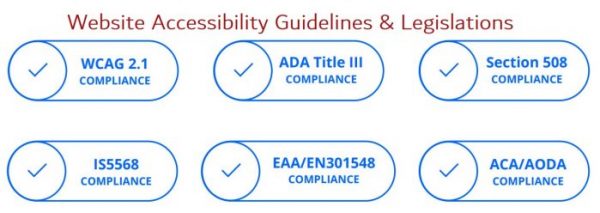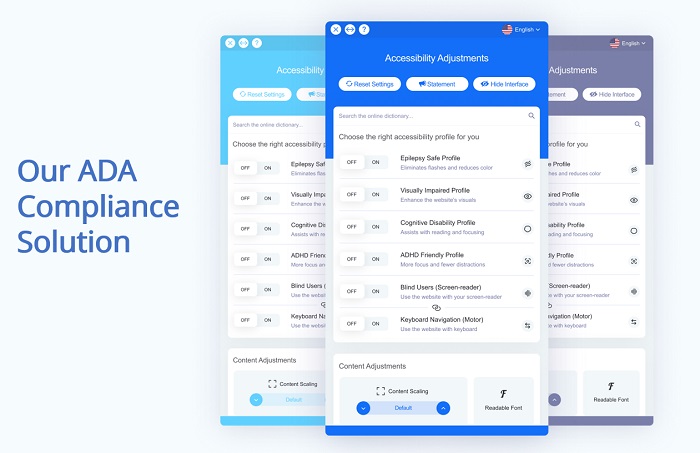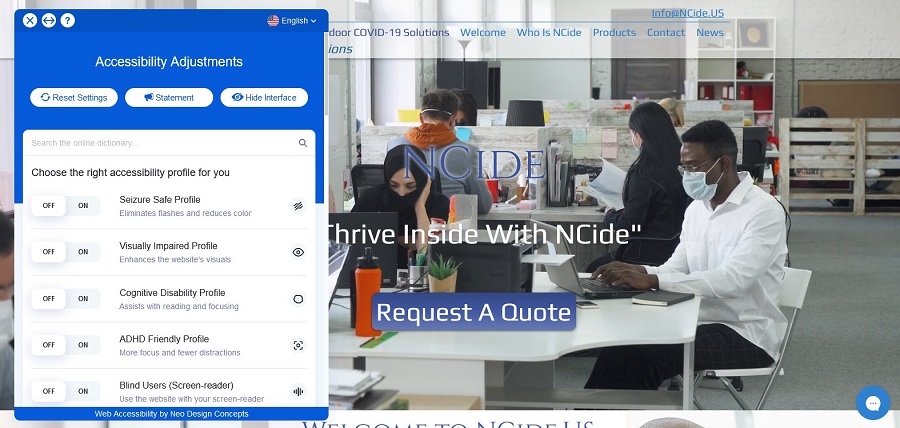ADA Web Accessibility
Web accessibility refers to designing and developing websites, tools and technologies to be usable by those with and without disabilities so all individuals can understand, navigate, contribute and interact with the Web. Adjustments for web accessibility should accommodate all types of disabilities that affect access to and enjoyment of the Web, including auditory, cognitive, neurological, physical, speech and visual. Currently, there are about 650 million people internationally living with some form of disability, which is approximately 10% of the world’s population.

Why Do Websites Need To Be Accessible To Those With Disabilities?
The Age of the Internet has propelled the world to retrieve the majority of its information, entertainment and communication from the Web. Business wise and personally, we are tightly intertwined with the Digital Grid, so much so it is very difficult to be totally off the Grid. We cannot leave our homes without our cell phones, as we feel it keeps us connected to our lives and with the world. Imagine how challenging life is for those with disabilities who cannot access the digital world.
On July 26, 1990, President George H. Bush signed into law the Americans with Disabilities Act (ADA), a civil rights law prohibiting discrimination against people with disabilities in several areas, including employment, transportation, public accommodations, communications and access to state and local government programs and services. Throughout the years, government agencies, corporations and institutions have been using portable document formats (PDF) as forms or applications to fill out on websites. More and more PDFs were uploaded onto the Web, as it became the accepted “final-form” electronic document format of choice. Unfortunately it was not web-based, unless tagged to be legible by those with visual impairment. The Web also has a wealth of rich graphics that can trigger seizures for a person with epilepsy. Someone with auditory impairment is at a disadvantage when trying to listen to podcasts or videos online. Therefore, those with disabilities cannot fully enjoy or use websites unless it is web accessible.
On January 22, 2018, Section 508 of the Rehabilitation Act and Section 255 of the Communications Act were finalized to encompass web accessibility in information and communication technologies (ICT). In short, all ICT hardware (printers, computers, cell phones, telecommunications equipment, etc.) and software (software, websites, intranets, word processing documents apps, PDFs, VoIP, etc.) are now considered a “place of public accommodations”, and are subject to the same accessibility rules as physical buildings. Which means these ICTs, including websites, need to allow for the same full and equal enjoyment of products, services or privileges as with any place of public accommodations for ALL users.
What Are Web Accessibility Regulations?
 The U.S. has the ADA Toolkit for State and Local Governments to follow with a Title II Checklist for web accessibility guidelines, but no formal regulations for private entities have been provided yet. Currently individuals, businesses, companies and organizations are referencing WCAG 2.0 AA and WCAG 2.1 AA for technical standards of web accessibility, and Title III of the ADA for interpreting websites as a place of public accommodations as shown below.
The U.S. has the ADA Toolkit for State and Local Governments to follow with a Title II Checklist for web accessibility guidelines, but no formal regulations for private entities have been provided yet. Currently individuals, businesses, companies and organizations are referencing WCAG 2.0 AA and WCAG 2.1 AA for technical standards of web accessibility, and Title III of the ADA for interpreting websites as a place of public accommodations as shown below.
“A public accommodation shall take those steps that may be necessary to ensure that no individual with a disability is excluded, denied services, segregated, or otherwise treated differently than other individuals because of the absence of auxiliary aids and services, unless the public accommodation can demonstrate that taking those steps would fundamentally alter the nature of the goods, services, facilities, privileges, advantages, or accommodations being offered or would result in an undue burden, i.e., significant difficulty or expense.”
How Neo Design Concepts Does Web Accessibility

Neo Design Concepts’ web accessibility software has bee developed to be compliant with ADA Title III, WCAG 2.1, Section 508, IS5568, EAA/EN301548 and ACA/AODA guidelines and legislation. As such, our program converts websites to be accessible to individuals with the following impairments: blindness, motor & mobility, color blindness, epilepsy, blurred vision, cognitive disorders, aging, cataracts and more.
Our software uses two components that work together to achieve compliance. The first component is the foreground application, or the accessibility interface, which is responsible for 30% of the requirements. It is mostly user interface and design-related.
Component 2 is our background application (AI, Machine Learning powered) that is responsible for the other 70% of requirements. It is mostly related to blind people’s screen-reader adjustments and keyboard navigation optimizations for people with motor impairments. Once integrated, it will start processing the website immediately and can take up to 48 hours to complete.
Legal Ramifications Of Web Accessibility Noncompliance
What can happen if a site is not web accessible? Unfortunately lawsuits can happen. The DOJ has affirmed that websites must apply ADA guidelines by November 2018. From 2017 to 2018, there have been a 200% increase in lawsuits and demands regarding web accessibility noncompliance. Of the demand letters received, 93% settle out of court for between $20,000 – $150,000. For the 7%, they battled and lost in court.
So don’t risk facing a demand letter. Contact info@neodesignconcepts.com or call (949) 682-8518 to have Neo Design Concepts seamlessly install web accessibility on your site. We provide complimentary web accessibility audits before and after the installation. Our annual subscription for standard size sites (less than 400 pages) are $599/year. We are offering FREE INSTALLATIONS until March 31, 2021.

You must be logged in to post a comment.